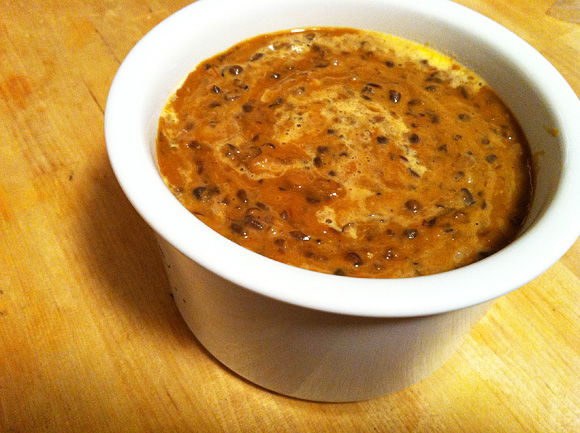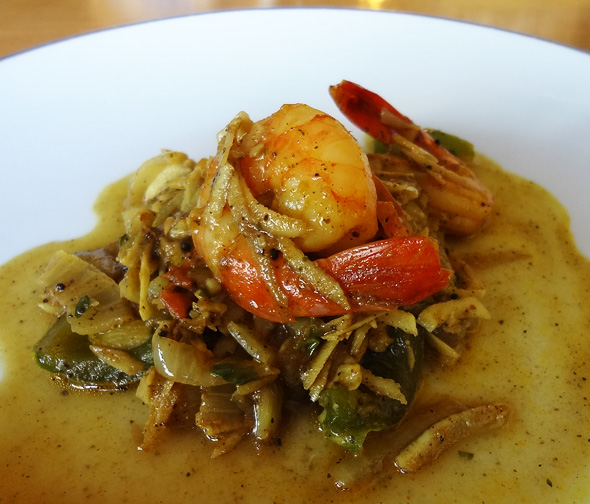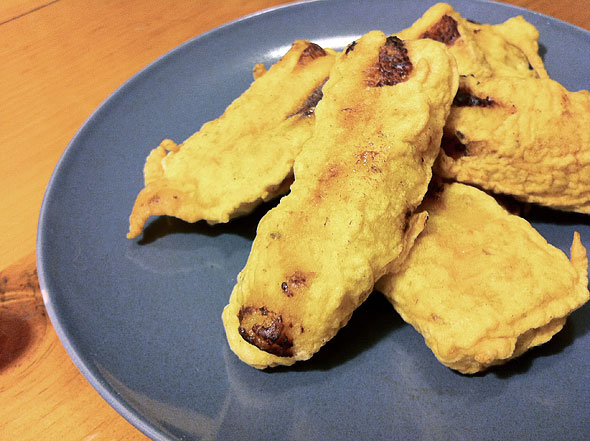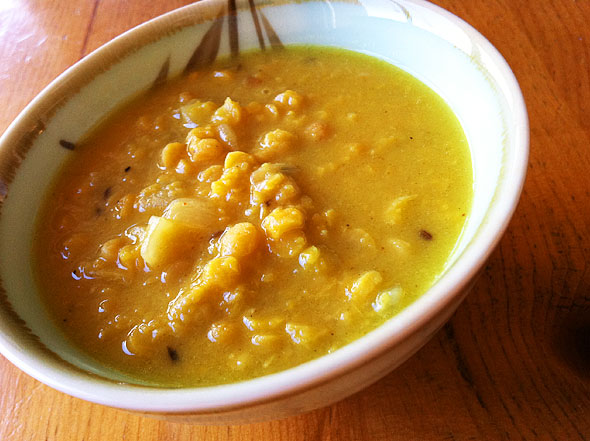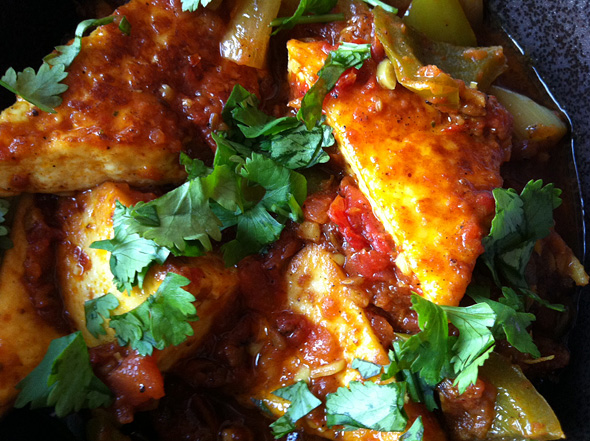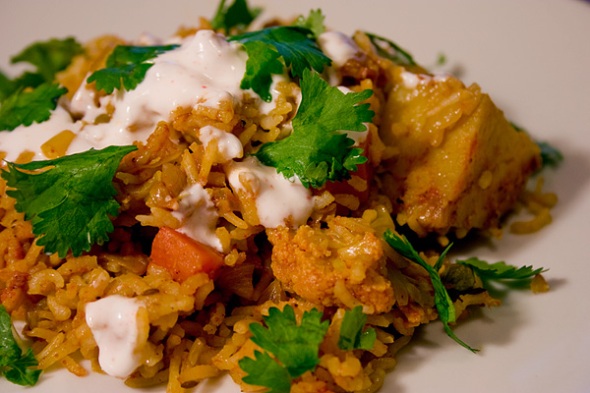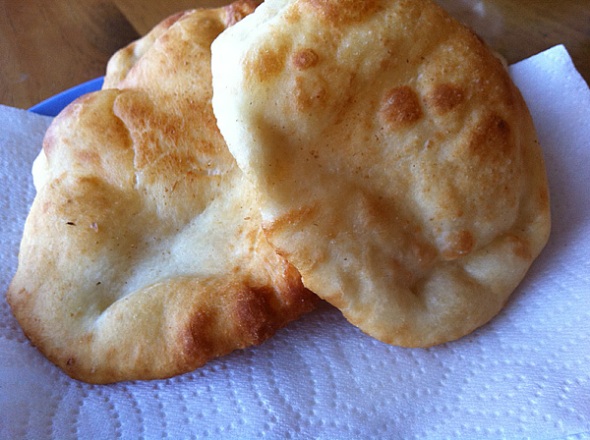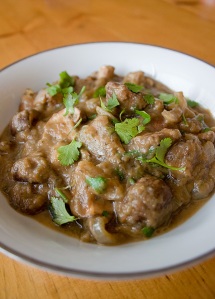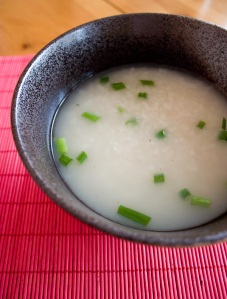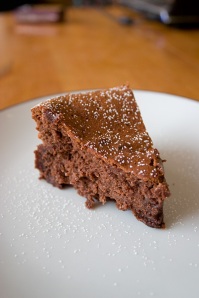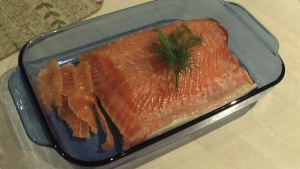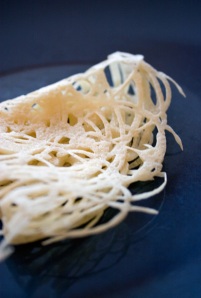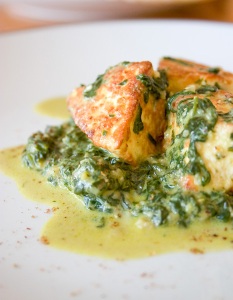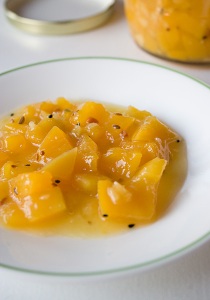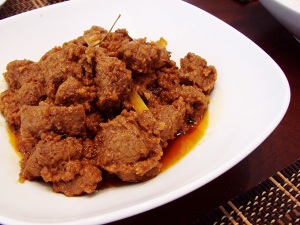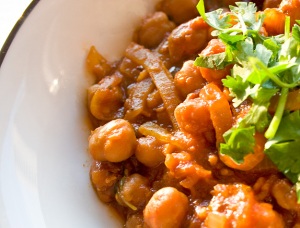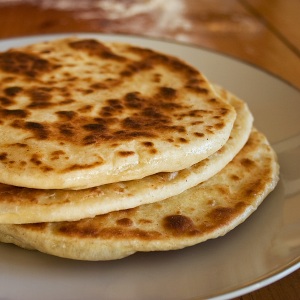Dal Makhani
I’ve always thought this was one of the worst-looking food dishes I’ve ever seen. Brownish-red slop with lumps in it. Totally awful. Then I tasted it.
That was, oh, 5 years ago, give or take. I’ve realized since then that your perception of food’s appearance is highly dependent on your experience with and enjoyment of the flavour. Now I see the same slop and think about how marvelous the deeper red colours are, how rich it looks with cream floating on the top. I understand now how black gram’s luxuriously creamy texture is one of the finest selling points of this dish.
Fresh Coconut and Shrimp Curry
You could subtitle this post “Or, a recipe that uses all that fresh coconut meat you just produced, because you followed my previous post’s instructions like the awesome person that you are.” Yes, it’s a shrimp curry that features fresh coconut. This is loosely inspired by South Indian spices and ingredients, and requires a medium amount of work because, hell, I like doing work in my kitchen. Why do you have to have everything done so fast?
Ethakka Appam
There are actually dozens of recipes for this snack online, with few variations from one to another. I suppose, then, it’s not essential to write my own, but damn it if these aren’t one of the tastiest mid-day snacks ever. I have to write about them. More importantly, I have some information to add about plantains.
Dal Tadka
About 3 years ago, I purchased a large bag of dried chana dal from Loblaws, having no idea what chana dal was, or what to do with it. What I did know was “lentils are healthy and I should be eating some lentils”. So I took this bag home and tried out a recipe from an Indian cookbook I had.
It turned out mostly terrible. Not only have I learned that the cookbook in question routinely calls for 50% of the salt needed to make anything taste good, the preparation steps were vague about how to cook the lentils themselves. Over the next few years, I tried the dish a few more times with mixed results – the lentils were too hard, not seasoned well, too dry, etc. Of course, it didn’t help that I had never actually eaten dal before. All I had was a picture of something that looked pretty good, and some brief descriptions of the finished product. I have this problem often.
Paneer Jalfrezi
We were out looking at possible wedding venues a few months ago, and were at what has turned out to be our choice location: The Sheraton Parkview. Like many venues, they deal with The Host, a popular Indian caterer in the Toronto area and, as luck would have it, The Host has a restaurant location directly below the Sheraton in an underground mall. A perfect chance to “test” some wedding menu options!
One of our meal picks was a tawa paneer dish – paneer pan-fried with peppers and onion. It was good, and seemed simple enough to make at home. I gave it a few whirls and had quality results each time (it also works well with mushrooms) but I got the idea to build a sauce base for it as well, thinking I was inventing a brand new curry. I wasn’t – what I was actually doing is making a jalfrezi-style curry.
Macaron Lab 1
Cookie: Rose Water and White Chocolate
Cookie Recipe: tant au tant mixture, 1+ tsp neon pink colour, added pinch of salt to meringue, otherwise basic recipe
Baking Details: my oven at 360 F (need to test heat with oven thermometer) for 10 minutes
Filling: white chocolate ganache (4 oz white chocolate to 3/8 cup 18% cream) + 1/2 tsp organic rose water, steeped cream with 3 green cardamom pods
Environment: July 10th, 10 pm, very humid, 30 C
Vegetable Biryani
This recipe is going to get a bit ridiculous. Fair warning. I was heading out into the Ontario farmlands with my two friends, Jim and Andrew, to record a rock and roll album at Chalet Studio, and since we were staying overnight, we needed to bring food. One problem: Jim is a stubborn vegan, and Andrew leans vegetarian (or at least, he did) so I built a hybrid vegan biryani out of recipe ideas for 3 or 4 vegetable curry and rice dishes. The end result was pretty great: a spicy-hot tomato curry infused into richly flavoured baked rice, with large pieces of potato, cauliflower, and carrot mixed throughout. The whole thing was topped with fried cashews and raisins, and lidded with phyllo pastry (egg-free, naturally).
Bhatoora
Edit: I’ve modified this recipe as of May 9th, 2011. The recipe and directions have changed. Deal with it. This one is better, and simpler.
As I mentioned in my Kheema post, the first time I had bhatoora/bhatura was in an Indian shop in Singapore. Before then I had tasted several kinds of naan. Naan is pretty popular now in North America and is manufactured by companies like President’s Choice and Dempster’s (don’t ever buy these if you’re craving Indian breads – they probably won’t taste the way you want them to) but India offers many kinds of breads that aren’t normally offered at buffet lines (which was, at the time, the only place I had ever had naan) and are not available commercially in most Western supermarkets including bhatoora, a puffy, deep-fried bread served often with chana masala (spiced chickpeas).
Shanghai Fried Noodles
Most of my Chinese food consumption happens at home (or in Scarborough). This dish has been a lunch mainstay in my family for years. The whole dish is cooked pretty quickly, but like with most Chinese dishes, there is a bit of prep that needs to be done before you fire up the stove. It’s simple, yet hearty and satisfying, and definitely not as oily as something you’d find in a mall food court.
This recipe is more of an outline rather than something set in stone. Feel free to swap the pork with other meat like chicken or beef, and while I’m only using napa here, you could also put some onions in to give it a little more flavour. Hell, put some other vegetables in there too if you want. However, the mildness of the napa works well with the other elements of the dish without complicating it too much.
Lastly, this recipe uses both light and dark soya sauce. This is important to point out because, unlike light soya sauce, which is salty, the dark soya is sweet. When combined, both sauces impart a more robust flavour onto the noodles. When it comes to eating, I like to pour a little bit of Scotch Bonnet hot sauce over the noodles for a bit of a sharp kick. If you’re not into spicy flavours you can leave it out.
Cremini Mushroom and Eggplant Curry
Cremini Mushroom and Eggplant Curry
This recipe is not really based on anything specifically traditional. Mushrooms are a fairly new addition to Indian cuisine, after all, so there’s not much history to speak of (and many restaurants don’t serve them). But, my girlfriend loves both mushrooms and eggplant, so there’s motivation to create right there. Plus, we’ve been looking for ways to eat a bit lighter (with more vegetables) lately, and this definitely fits the bill.
Rice Porridge
Rice Porridge
Years back, on my trip to Thailand, I was taking an overnight train from Bangkok to Chiang Mai. It was a long enough trip for them to include dinner and breakfast in the ticket price. It was an interesting experience without even mentioning the food; the sleeper accommodations featured two seats that transformed (through your own labour) into a bunk with retractable opaque screens and your neighbours placed literally 5-6 feet away behind their own screen, across the aisle. I’m not exactly a luxury traveler and I wasn’t expecting much, but I’ll admit it was a little disconcerting to know I was changing my underwear in such a vulnerable situation. Still more disconcerting was the train staff’s wake-up call tactic of sticking their heads into your compartment without knocking (or in this case, tapping on the fabric screen?), yelling “Good morning! Time for breakfast!” in Thai-accented English with a huge smile. I’m a morning person, but please.
Simple Chicken Stock
This is a Chinese-inspired chicken stock; something a bit different from Western chicken stock and employing flavours that compliment Asian and Southeast Asian foods. A lot of Asian recipes will ask for chicken stock (Thai curries, or noodle dishes, etc) and while basic Western stock will work OK, this version will add a nice subtle touch of Asian influence. Why not?
Red Curry Paste
Now I know jarred red curry paste is sold just about everywhere, and I use it all the time, too; it’s simply easier, cheaper, and faster to keep a jar of it in your fridge. But sometimes, a person gets inspired. There’s a certain joy and sense of satisfaction in the manual labour of producing your own basics, like stock, mayonnaise, or cheese, that buying pre-made does not afford. Call me crazy, but spending an extra 30 minutes preparing this recipe is very enjoyable. Plus, there’s a few layers of flavour that the fresh ingredients provide that preserved pastes do not. Is it worth it? That’s up to you.
Pad Thai
Pad Thai: everyone’s favourite Thai dish. So it seems anyway – I even know some people who eat Pad Thai to the exclusion of all other Thai dishes, ever. It’s not too hard to see why, though, since Pad Thai is such a great balance of flavours; there’s so much going on that it satisfies on multiple levels. It’s the sauce that does it – that sauce that is so mysterious at first taste – and it’s dead easy to reproduce perfectly.
Nutella Cake
This is the cake I posted about on the Facebook page. The recipe is based off of the chocolate cake recipe in David Lebovitz’ book The Sweet Life in Paris (the one I gushed about in my travelogues, etc). Actually, based on my Food Network watching and reading other cake recipes, this is the cake recipe that many restaurants sell to you as a “warm chocolate cake” or, depending on how you bake it, a “molten lava cake”.
How to Make Gravlax at Home
Gravlax, pronounced grav-lox, is a Swedish dish of cold-cured salmon. Gravlax is like smoked salmon, but instead of cold smoking it, it’s cured. Originally, it was cured by burying the salmon underground, hence grav (grave/buried under the ground) and lax (salmon), however you won’t need a shovel to make this recipe. It is incredibly simple to make, while still making you look incredibly impressive to all your friends, or even just yourself. Nothing quite like saying “oh yes, I cured the salmon myself.” Also, compared to smoked salmon, or even gravlax you’d buy in a supermarket, way cheaper.
Basic Curry
Basic Curry
Some days – a few every month – I’m not really in the mood for doing a lot of work to put food on the table. I still want something good, but uncomplicated and containing only a few, simple ingredients. Some days, that means grilled cheese sandwiches, and other days this recipe for simple chicken curry. “Curry is simple and not a lot of work?”, I hear you ask, incredulous. Well, it’s true – or more true than false.
Roti Jala
Roti Jala
Roti Jala translates to “net bread” from Malay. For obvious reasons. In the simplest terms, it’s a coconut crepe. The batter is a similar formula to a crepe or thin pancake, except that coconut milk replaces regular milk. That sounds good, right? It is.
The tricky thing about this is achieving the pretty lace quality of the crepe. In Malaysia, they have these little plastic things called Roti Jala Molds. Here is a photo of one in action. I imagine they are ridiculously cheap, but unfortunately, they are not sold in Toronto – or, at least, I have no idea where I’d find one. I tried making roti jala without a mold (using a free-pour style out of a measuring cup) and I got a lot of blobs and large streaks of batter in the pan. It tastes fine, but does not make my eyes happy. I tried punching holes in the bottom of a styrofoam cup. That didn’t really work, either. The batter wouldn’t run through the holes until I punched them quite large, and then it just dripped out in blobs, making a mess.
Saag Paneer
Saag Paneer
Remember that time? The first time you went to an Indian restaurant (for buffet, naturally) and your eyes and nose were overwhelmed by unfamiliar colours and smells? Maybe you were more daring than me, but I hesitated when I swirled the ladle around in the tray of saag paneer. White cubes of something (I didn’t know what) hidden in a thick green soup of unknown origin. My gut reaction was repulsion, and I believe I made a comparison involving swamp slime.
As is often the case, I was wrong. So wrong. Perhaps the subtleties were lost in the dense haze of 2 dozen dishes mixing their smells in the same room, but saag paneer, despite its appearance, is a dish for kings. Or me. The paneer is rich with crisp, chewy edges and pillow-y center. The spinach is softened and thickened with cream, flavoured with a spice blend that is a good balance between earthy and delicate. It seems fairly simple (cheese+spinach+cream), but the flavours are layered and complex.
Mango Chutney
Mango Chutney
Oh, mango chutney, the ketchup of North Indian restaurants. Papadum served with chutneys, samosas with chutney – everyone’s familiar with the basic concept. Except they’re probably only familiar with the Western versions – “chutney” can refer to a wide class of preparations much different than what we commonly understand. That’s not what I want to talk about, though.
I want to talk about preserving, or pickling. This mango chutney is technically a pickle. In the simplest terms, a pickle is a mixture whose pH leans heavily towards acidity (<4.6 pH officially) and that acidity is strong enough to kill bacteria and other fun things – all of which means you can store it (the pickle) for quite a long time without it going bad. Since vinegar and lemon juice’s pHs are 2.4 and 2.2 respectively, either can be used here. To help keep the interior of the jar safe, we need a clean jar, and a tight lid. By clean, I mean it should probably be boiled (or washed in a hot cycle of a dishwasher) beforehand, and dried with a fresh towel.
Rendang Daging
Rendang Daging
Historically, this beef dish originates in Western Sumatra, Indonesia with the Minangkabau ethnic group, and dates back at least 500 years in literature. Or that’s what I’ve gleaned from Wikipedia, anyway. My personal experience with the dish dates back to a lunch-time cafeteria in Singapore. I remember enjoying the dish, but otherwise have completely forgotten the flavour. Maybe that’s a good thing, since cheap cafeterias ordinarily don’t produce the greatest versions of things. Who knows?
Whatever it was, though, it impressed me enough to inspire an ongoing quest to make rendang (pronounced ren-dahng, daging is dah-ging) at home, here in Canada. I found some Indofoods rendang spice packets at Loblaws, so it is popular enough to infiltrate the Western marketplace in some form, but the resulting mess was sub-standard. Hell, most of those spice packets produce only a pale imitation of the real thing. For many Southeast Asian foods, you need fresh ingredients. Lemongrass, ginger, shallots, garlic, and so on. Which means I needed a real recipe. For rendang, specifically, you need all of those aromatics and spices, plus one more crucial ingredient: infinite patience.
Khao Soi
Khao Soi
Once upon a time, I was vacationing in Thailand and, instead of staying in one spot, I took buses and trains all over the country. One of the places I stopped was Chiang Mai, the largest city in Northern Thailand. I had my trusty Lonely Planet guidebook to get around, and one of the restaurants recommended in the book served a dish described as a “Shan-Yunnanese concoction of chicken, spicy curried broth and flat, squiggly noodles”. I’d never heard of it, but it sounded interesting and seemed to be popular in the city.
As it turned out, khao soi is something of a regional specialty and has inspired a small cult following (including blogs like The Quest for Khao Soi) as the dish is rarely made outside of Northern Thailand. It’s a shame, really – outside of Chiang Mai, it is somewhat difficult to find this dish on a menu, despite it being very Western palate-friendly, visually appealing and relatively cheap and easy to make, not to mention addictive as hell. However, it may be obscure because its roots are as peculiar as its isolation – it was invented through the travels of Chinese Muslim spice traders through Northern Laos, Thailand and Burma. The curry’s spice is flavoured with imported Burmese and Indian spices such as cumin, coriander seed, turmeric, fenugreek and cinnamon. Then it’s grounded in more commonly Thai ingredients like cilantro, galangal, chilies, kaffir lime, coconut milk broth seasoned with fish sauce and perhaps a bit of palm sugar.
Chana Masala
Chana Masala
Chana Masala – another one of those Indian buffet staples – means simply “spiced chickpeas” (or close enough). My most memorable experience eating chana masala was not at a buffet, but at a downtown food court in Boston. It’s not that it was great food (it was good) but I did find it surprising that there was an Indian vendor at a food court. It made me realize that in Toronto, there is no food court (outside of Gerrard st.) I know of has any Indian food, and I’ve been to many food courts (sadly). One day, I hope that changes. I’m getting tired of Manchu Wok, and don’t even get me started on Subway. Ok, moving on…
Paratha: A Relatively Complete Guide
Paratha – my Achilles heel. Not only is it bread, it’s fried bread. Fried, flaky, layered flat-bread – each inner layer is moist and buttery, the outer layer crispy and hot. Sigh. Like the ghee worked into the dough, I melt…
But let’s not get carried away. These things are so thick with ghee that even *I* feel a little guilty about indulging. You see, paratha is made by rolling out dough, slathering ghee on the surface, folding the dough over, and slathering on more ghee. You repeat this a few times until you have a rolled-out dough with multiple layers and pockets filled with ghee, ready to melt and sizzle instantly when the dough hits the pan.

